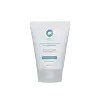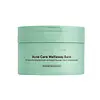What's inside
What's inside
 Key Ingredients
Key Ingredients

 Benefits
Benefits

 Concerns
Concerns

 Ingredients Side-by-side
Ingredients Side-by-side

Ethylhexyl Palmitate
EmollientHydrogenated Styrene/Isoprene Copolymer
Neopentyl Glycol Dicaprate
EmollientTriethylhexanoin
MaskingDextrin Palmitate
EmulsifyingEthylhexyl Palmitate, Hydrogenated Styrene/Isoprene Copolymer, Neopentyl Glycol Dicaprate, Triethylhexanoin, Dextrin Palmitate, Polyethylene, Laureth-4, PEG-8 Glyceryl Isostearate, Helianthus Annuus Seed Oil, Squalane, Phenoxyethanol, Tocopherol, Centella Asiatica Extract, Sodium Acetylated Hyaluronate
Ethylhexyl Palmitate
EmollientCaprylic/Capric Triglyceride
MaskingPEG-20 Glyceryl Triisostearate
EmollientCetyl Ethylhexanoate
EmollientPEG-12 Diisostearate
EmulsifyingPolyethylene
AbrasivePhenoxyethanol
PreservativeWater
Skin ConditioningCaprylyl Glycol
EmollientGlucosylrutin
AntioxidantCharcoal Extract
Skin ConditioningLactic Acid
BufferingMandelic Acid
AntimicrobialMalic Acid
BufferingLactobionic Acid
BufferingGlycolic Acid
BufferingCapryloyl Salicylic Acid
ExfoliatingSalicylic Acid
MaskingParfum
MaskingTocopherol
AntioxidantCentella Asiatica Extract
CleansingSalix Alba Bark Extract
AstringentBixa Orellana Seed Extract
MaskingSodium Hyaluronate
HumectantEthylhexyl Palmitate, Caprylic/Capric Triglyceride, PEG-20 Glyceryl Triisostearate, Cetyl Ethylhexanoate, PEG-12 Diisostearate, Polyethylene, Phenoxyethanol, Water, Caprylyl Glycol, Glucosylrutin, Charcoal Extract, Lactic Acid, Mandelic Acid, Malic Acid, Lactobionic Acid, Glycolic Acid, Capryloyl Salicylic Acid, Salicylic Acid, Parfum, Tocopherol, Centella Asiatica Extract, Salix Alba Bark Extract, Bixa Orellana Seed Extract, Sodium Hyaluronate
 Reviews
Reviews

Ingredients Explained
These ingredients are found in both products.
Ingredients higher up in an ingredient list are typically present in a larger amount.
Centella Asiatica Extract (Centella) is derived from an herb native to Southeast Asia. It is famous for its anti-inflammatory and soothing properties.
Centella is rich in antioxidants and amino acids, such as Madecassic Acid and Asiaticoside.
Studies show the compounds in centella help with:
The combination of all these properties makes centella effective at soothing, hydrating, and protecting the skin.
Other great components of centella include Vitamin A, vitamin C, several B vitamins, and Asiatic Acid.
Fun fact: Centella has been used as a medicine and in food for many centuries. As a medicine, it is used to treat burns, scratches, and wounds.
Learn more about Centella Asiatica ExtractEthylhexyl Palmitate, also known as octyl palmitate, is created from 2-ethylhexyl alcohol and palmitic acid. It is a fatty acid ester.
The fatty acid content of Ethylhexyl Palmitate makes it an emollient. Emollients help soften and hydrate your skin by trapping moisture within.
Ethylhexyl Palmitate is also used to help improve the texture of cosmetics. It helps other ingredient dissolve in products and help disperse ingredients more evenly.
You'll likely find this ingredient in sunscreen, as it is often used to mix UV-blocking ingredients such as avobenzone and ethylhexyl triazone.
It can also help stabilize the fragrances in a product as a fragrance fixative.
Ethylhexyl Palmitate can be used to substitute mineral oil.
Due to its high fatty acid content, it may not be fungal-acne safe.
Learn more about Ethylhexyl PalmitatePhenoxyethanol is a preservative that has germicide, antimicrobial, and aromatic properties. Studies show that phenoxyethanol can prevent microbial growth. By itself, it has a scent that is similar to that of a rose.
It's often used in formulations along with Caprylyl Glycol to preserve the shelf life of products.
Polyethylene is a synthetic ingredient that helps the skin retain moisture. It is a polymer.
It is also typically used within product formulations to help bind solid ingredients together and thicken oil-based ingredients. When added to balms and emulsions, it helps increase the melting point temperature.
Tocopherol (also known as Vitamin E) is a common antioxidant used to help protect the skin from free-radicals and strengthen the skin barrier. It's also fat soluble - this means our skin is great at absorbing it.
Vitamin E also helps keep your natural skin lipids healthy. Your lipid skin barrier naturally consists of lipids, ceramides, and fatty acids. Vitamin E offers extra protection for your skin’s lipid barrier, keeping your skin healthy and nourished.
Another benefit is a bit of UV protection. Vitamin E helps reduce the damage caused by UVB rays. (It should not replace your sunscreen). Combining it with Vitamin C can decrease sunburned cells and hyperpigmentation after UV exposure.
You might have noticed Vitamin E + C often paired together. This is because it is great at stabilizing Vitamin C. Using the two together helps increase the effectiveness of both ingredients.
There are often claims that Vitamin E can reduce/prevent scarring, but these claims haven't been confirmed by scientific research.
Learn more about Tocopherol